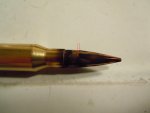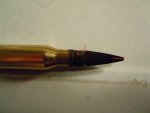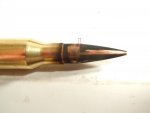First, I'm a total newbie at hand loading. I'm struggling with bullet seating depth determination. I have had success with my first 20 rounds. I seated the bullets to match the factory ammo I had on hand that have the same 140 grain Berger VLDs. I used the Hornady Bullet Comparator to take measurements. The first batch of 20 rounds shot just fine.
I'm having no luck with the home brew methods of determining when the rifle lands hit the ogive - smoke, sharpie, floppy bolt with the firing pin removed. I just can't get a decent read. So I tried something else. In a sized, dummy round I seated the bullet way long (shallow). The bolt didn't want to close and sometimes the round stuck in the chamber. (Pushed out with cleaning rod) I seated deeper and deeper until the bolt closing feels right and the rounds don't jam. And now I have a new measurement.
But here's where I get nervous. When I duplicated the factory ammo the measurement is 2.156". They shot fine. Playing with the dummy round I am coming up with 2.2725" when the round doesn't jam and the bolt feels like I'm not forcing it. That's a big delta - 0.119" longer (shallower) than the factory ammo. That sounds like a lot to me. I know I should seat a few thousandths deeper for my production run, but I don't know if I'm kidding myself and I'm still jamming the bullet in the rifling and going to create an overpressure problem.
Am I over thinking this? Am I about to blow my face off?
Some other info - Weatherby Sporter in 7mm-08. Factory ammo is HSM, with 140 grain Berger VLDs.
Thanks
I'm having no luck with the home brew methods of determining when the rifle lands hit the ogive - smoke, sharpie, floppy bolt with the firing pin removed. I just can't get a decent read. So I tried something else. In a sized, dummy round I seated the bullet way long (shallow). The bolt didn't want to close and sometimes the round stuck in the chamber. (Pushed out with cleaning rod) I seated deeper and deeper until the bolt closing feels right and the rounds don't jam. And now I have a new measurement.
But here's where I get nervous. When I duplicated the factory ammo the measurement is 2.156". They shot fine. Playing with the dummy round I am coming up with 2.2725" when the round doesn't jam and the bolt feels like I'm not forcing it. That's a big delta - 0.119" longer (shallower) than the factory ammo. That sounds like a lot to me. I know I should seat a few thousandths deeper for my production run, but I don't know if I'm kidding myself and I'm still jamming the bullet in the rifling and going to create an overpressure problem.
Am I over thinking this? Am I about to blow my face off?
Some other info - Weatherby Sporter in 7mm-08. Factory ammo is HSM, with 140 grain Berger VLDs.
Thanks






